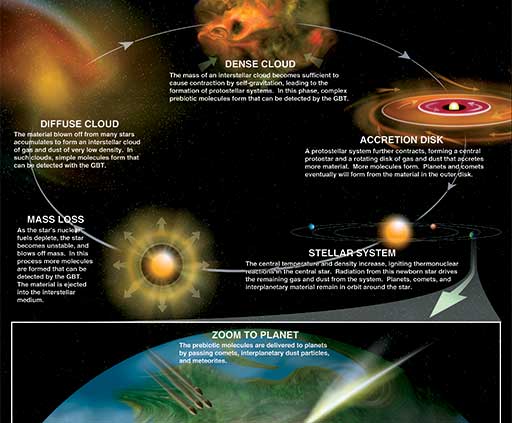
The image can be found here was created by Bill Saxton, NRAO/AUI/NSF
Within the universe there are galaxies, and within these galaxies, such as the Milky Way which we are a part of, there can be billions of stars. Between these stars there is a lot of space that holds matter, such as gas and dust, and this matter is what is known as the interstellar medium or the ISM for short. The material that comprises the ISM is not uniform; it ranges in temperature and density depending upon the stage of galactic evolution. However, matter in the ISM goes through cycles which impact and are impacted by the birth and death of stars, respectively. Matter of the ISM starts off in a cold diffuse cloud, and as the gas and particles of the ISM begins to condense, stars and planets form from this matter. As a star ages and dies, it emits matter back into the interstellar space. (See figure to the left) This cyclical process ends up dictating the lifespan of active star formation within the galaxy, the composition of stars, and the chemical complexity of the resulting planets. Thus, by determining the chemical composition of the ISM towards different star systems, we can begin to understand what might make that area of space different from other areas, and eventually we hope that it will lead us to understand the chemical evolution that takes place over time in the ISM. This would help lead us to answer questions about how life came to be about on Earth, as it is possible that the seeds to life were transported here from the ISM.
While there are still a lot of open questions about the chemistry that happens in the ISM, two families of molecules have been particularly absent in the chemical inventory of the ISM. The first class of molecules are ones that contain sulfur atoms. This is despite the fact that sulfur, a molecule important for life, has been shown to be an abundant element in the ISM. One of the reasons sulfur bearing species aren’t prevalent in the chemical inventory is due to the their limited laboratory datasets. They can be difficult and smelly to work with, and it can also be difficult to generate species that are not stable here on Earth in the lab. Thus, new and inventive ways are needed to make these unstable species, such as a discharge nozzle. By developing a method to study them and obtaining spectra of more complicated species, radio astronomers can look for them in their astronomical datasets. Each subsequent detection will further our understanding of complexity of sulfur, and they will shed new light on possible sources for the sulfur “sink” for astrochemical models. The second class of species that, until recently, were something of a mystery are polycyclic aromatic hydrocarbons (PAHs) – or ring species that are made from carbon and hydrogen. These species are thought to contain up to 20% of the galactic carbon, and they are thought to be important for ice grain formation and the catalysis for larger molecules. However, in 2021, indene was discovered by Prof. Cernicharo and his team and simultaneously by Burkhardt et al., followed by the detection of a closely related molecule – cyanonaphthalene by McGuire et al. PAHs, as a general rule, do not produce rotational spectra due to their lack of a dipole moment. This means detecting them is difficult in the ISM. However, if a side group, such as a CN group is added to the PAH, a rotational spectrum is then generated. Thus, by using creative laboratory techniques, such as a discharge nozzle, we can generate these substituted PAHs and look for them in the ISM. Thus we set out to build up a laboratory inventory of sulfur bearing species and substituted PAHs through the use of discharge nozzles in order to help generate knowledge about the chemistry happening in the interstellar medium.
